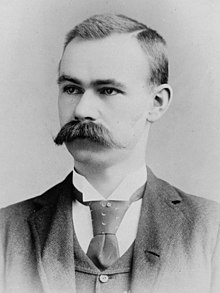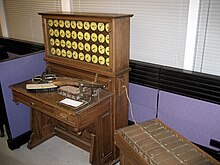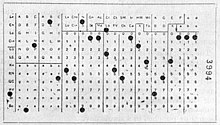Herman Hollerith
Herman Hollerith | |
|---|---|
 Herman Hollerith in 1888 | |
| Born | February 29, 1860 |
| Died | November 17, 1929 (aged 69) |
| Resting place | Oak Hill Cemetery |
| Education | City College of New York (1875) Columbia University School of Mines (1879) |
| Occupation(s) | Statistician, inventor, businessman |
| Known for | mechanical tabulation of punched card data |
| Spouse |
Lucia Beverley Talcott (1865–1944)
(m. 1890–1929) |
| Awards | Elliott Cresson Medal (1890) |
Herman Hollerith (February 29, 1860 – November 17, 1929) was an American statistician who developed a mechanical tabulator based on punched cards to rapidly tabulate statistics from millions of pieces of data. He was the founder of one of the companies that later merged and became IBM.
Personal life
Hollerith was born as a son of German immigrant Prof. Georg Hollerith from Großfischlingen (near Neustadt an der Weinstraße) in Buffalo, New York, where he spent his early childhood. He entered the City College of New York in 1875 and graduated from the Columbia University School of Mines with an "Engineer of Mines" degree in 1879. In 1880 he listed himself as a mining engineer while living in Manhattan, and completed his Ph.D. in 1890 at Columbia University. He eventually moved to Washington, D.C., living in Georgetown, with a home on 29th Street and ultimately a factory for manufacturing his tabulating machines at 31st Street and the C&O Canal, where today there is a commemorative plaque placed by IBM. He died in Washington D.C.
Electrical tabulation of data

At the urging of John Shaw Billings,[1] Hollerith developed a mechanism using electrical connections to trigger a counter, recording information. A key idea was that data could be coded numerically. Hollerith determined that if numbers could be punched in specified locations on a card, in the now-familiar rows and columns, then the cards could be counted or sorted mechanically and the data recorded. A description of this system, An Electric Tabulating System (1889), was submitted by Hollerith to Columbia University as his doctoral thesis, and is reprinted in Randell's book.[2] On January 8, 1889, Hollerith was issued U.S. Patent 395,782,[3] claim 2 of which reads:
The herein-described method of compiling statistics, which consists in recording separate statistical items pertaining to the individual by holes or combinations of holes punched in sheets of electrically non-conducting material, and bearing a specific relation to each other and to a standard, and then counting or tallying such statistical items separately or in combination by means of mechanical counters operated by electro-magnets the circuits through which are controlled by the perforated sheets, substantially as and for the purpose set forth.
Inventions and businesses

Hollerith had left teaching and begun working for the United States Census Office in the year he filed his first patent application. Titled "Art of Compiling Statistics", it was filed on September 23, 1884; U.S. Patent 395,782 was granted on January 8, 1889.[4] Patents 395,781 395,782 and 395,783 was published in the Scientific American on January 18, 1889.[5]

Hollerith built machines under contract for the Census Office, which used them to tabulate the 1890 census in only one year.[6] The 1880 census had taken eight years. Hollerith then started his own business in 1896, founding the Tabulating Machine Company. Most of the major census bureaus around the world leased his equipment and purchased his cards, as did major insurance companies. To make his system work, he invented the first automatic card-feed mechanism and the first key punch (that is, a punch operated by a keyboard); a skilled operator could punch 200–300 cards per hour. He also invented a tabulator. The 1890 Tabulator was hardwired to operate only on 1890 Census cards. A plugboard control panel in his 1906 Type I Tabulator allowed it to do different jobs without being rebuilt (the first step towards programming). These inventions were among the foundations of the modern information processing industry.
In 1911 four corporations, including Hollerith's firm, merged to form the Computing Tabulating Recording Company (CTR).[7] Under the presidency of Thomas J. Watson, it was renamed International Business Machines Corporation (IBM) in 1924.
See Also
- Hollerith constants, also sometimes called Hollerith strings, were an early type of string constant declaration (in computer programming), named after Herman Hollerith.
Notes
- ^ Lydenberg, Harry Miller (1924). John Shaw Billings: Creator of the National Medical Library and its Catalogue, First Director of the New York Public Library. American Library Association. p. 32.
- ^ Randell (ed.), Brian (1982). The Origins of Digital Computers, Selected Papers (3rd ed.). Springer-Verlag. ISBN 0-jhh87-11319-3.
{{cite book}}:|last=has generic name (help); Check|isbn=value: invalid character (help) - ^ US patent 395782, Herman Hollerith, "Art of compiling statistics", issued 1889-01-08
- ^ The Invention and Development of the Hollerith Punched Card
- ^ Publication of Hollerith patents
- ^ Hollerith's Electric Sorting and Tabulating Machine, ca. 1895 from the American Memory archives of the Library of Congress
- ^ "IBM Archives: Frequently Asked Questions" (PDF). Some accounts of the merger forming CTR state that three corporations were merged. This reference notes that only three of the four merged corporations are represented in the CTR name. That may be the reason for the differing accounts.
Further reading
- Austrian, G.D. (1982). Herman Hollerith: The Forgotten Giant of Information Processing. Columbia. ISBN 0-231-05146-8.
- Heide, Lars (2009). Punched-Card Systems and the Early Information Explosion, 1880-1945. Johns Hopkins. ISBN 0-8018-9143-4.
- Essinger, James (2004). Jacquard's Web: How a Hand-Loom Led to the Birth of the Information Age. Oxford: Oxford University Press.
- Hollerith, Herman (1890). In connection with the electric tabulation system which has been adopted by U.S. government for the work of the census bureau (Ph.D. dissertation). Columbia University School of Mines.
- Hollerith, H. (1889). "An Electric Tabulating System". The Quarterly, Columbia University School of Mines. X (16): 238–255.
{{cite journal}}: Unknown parameter|month=ignored (help) - Hollerith, Herman (1894). "The Electric Tabulating Machine". Journal of the Royal Statistical Society. 57 (4). Journal of the Royal Statistical Society, Vol. 57, No. 4: 678–682. doi:10.2307/2979610. JSTOR 2979610.
{{cite journal}}: Unknown parameter|month=ignored (help)
External links

- Template:Worldcat id
- Hollerith's patents from 1889: US 395781 US 395782 US 395783
- IBM Archives: Herman Hollerith
- IBM Archives: Tabulating Machine Co. plant
- Early Office Museum: Punched Card Tabulating Machines
- Hollerith page at the National Hall of Fame
- Map to his gravesite
- Columbia University Computing History: Herman Hollerith
- O'Connor, John J.; Robertson, Edmund F., "Herman Hollerith", MacTutor History of Mathematics Archive, University of St Andrews
- The Norwegian Historical Data Center: Census 1900 Includes a description of the use of Hollerith machines ("complicated, American enumeration machines"), together with illustrations.
- Fleishman, Sandra (March 5, 2005). "$8.5 Million And Counting". Washington Post. Retrieved May 4, 2010.
{{cite news}}: Cite has empty unknown parameter:|coauthors=(help) – Hollerith's house
- American statisticians
- American inventors
- Computer pioneers
- 1860 births
- 1929 deaths
- National Inventors Hall of Fame inductees
- People from Buffalo, New York
- City College of New York alumni
- Columbia University alumni
- Columbia School of Engineering and Applied Science alumni
- Elliott Cresson Medal recipients
- Burials at Oak Hill Cemetery
- American people of German descent
